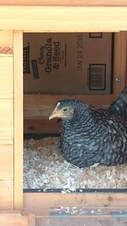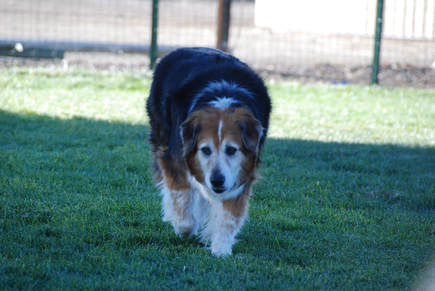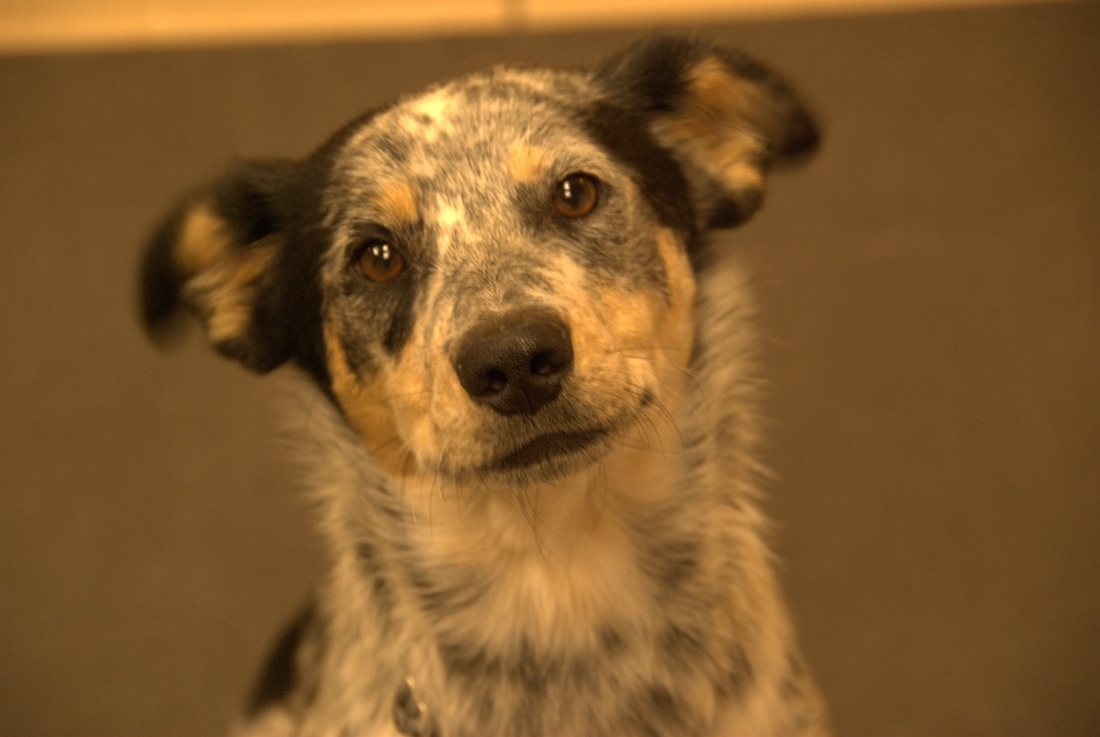 My dog or cat (or rabbit, or chicken) spends the day outside… If your pet spends the day outside, it is possible to keep them safe even in very hot weather, as long as they are healthy. Healthy animals with normal mobility are pretty capable when it comes to keeping themselves as comfortable and safe as possible if provided with appropriate resources. Be aware that pets with short, flat faces (brachycephalic animals) or conditions that affect breathing (such as laryngeal paralysis) may be at risk of overheating when the temperature rises above 80 degrees Fahrenheit, even with appropriate shade, water, etc… Shade Shade is crucial. If your pet is outside in hot weather, make sure that there is an area available for shelter from heat that is open to moving air and provides an area of all day, full shade at least twice as large his or her bed. This shaded area must be protected by a wall, fence, double layer of shade cloth, or reflective space blanket on the south side to prevent sun exposure from the “hot” side. There must also be an overhang, which can be a roof, double layer of shade cloth, space blanket, pop-up shade structure, or mature tree. Water needs to be available in this fully shaded area, ideally positioned near the center of the “wall” or in a corner to prevent exposure of the water dish to sun and excessive heat. Rabbits with outdoor run areas may appreciate an artificial burrow, which could be created using retaining wall bricks for walls and a wide board to create a roof, which can be covered with dirt. The entrance should be north-facing, and shading the area is ideal. Water Provide at least twice as much water as you think your pet might need, which means at least 2.5 quarts (10 cups) of water per 25 lbs of dog, and 2 cups of water per 8 lbs of cat or rabbit. Remember that larger amounts of water will warm up less quickly, and excess provides “room for error” in case your pet steps in the dish or an unexpected visitor (raccoon, cat) comes to tank up! Automatic watering systems are a great idea, with some caveats. It is essential that the entire unit be shaded from the faucet (or tank, if the system is gravity-fed) to the dish or sipper. It is essential to test all outlets on such systems daily to make sure that water flow starts and stops like it is supposed to, and to check both the line and outlets for leaks. Check the outlets daily for debris or build-up that could affect the function of the unit or palatability of the water. Make sure that outlets are cleaned thoroughly at least once weekly. It is prudent to have a second bottle available to small mammals who rely on LIXIT-style bottles for water, in case one unit drips and goes dry. Rabbits and chickens may not drink enough when it is hot, leading to dehydration and intestinal distress. Electrolyte preparations are available for both species. When electrolytes are used, only water with electrolytes should be available. Adding probiotics to the animal’s regimen may also help prevent intestinal distress. Probiotics administered in water are available for rabbits and for chickens. If your dog is prone to stop drinking with stress, offering diluted bone, chicken, or beef broth twice daily may be helpful. Alternatively, mixing a small amount of meat baby food or other pureed meat into water may promote water consumption. Never leave broth or water with meat mixed into it out for more than an hour before discarding the remainder, or bacterial growth may cause intestinal problems. Flavored water may also be attractive to insects, especially flies. Cats may be encouraged to drink more by offering water in a recirculating fountain, or simply by placing water in more locations, especially near favored resting spots. Misters Mister systems can be a great way to keep an area cooler. I do recommend putting them on a timer to prevent the formation of a mud pit or wading pond. It is acceptable to have the mister spray part of the shaded area, but the entire area should not be treated in case your pet needs a dry space to rest in. For rabbits housed in hutches, or chickens, misters can be mounted on the roof of the hutch or coop, on top/outside of the animal’s living space, to keep the roof, and thus the living area, cooler. Never put misters directly on the animals or where their food or bedding will get wet to minimize the risk of mold growth, fly/maggot exposure, etc. Ice Some animals like their water cool. Putting ice cubes or frozen, hard-sided cooler packs in the water dish helps keep it cool. If you do this, do provide 2 water containers, one with and one without the ice, just in case your pet needs the water to be closer to the ambient temperature in order to drink. Dogs and chickens get tremendous enjoyment from ice blocks with frozen food treats inside. Both species like chunks of meat, fruits, and vegetables in their ice blocks. There are containers complete with platters that you can use to make ice blocks, or you can use your own plate or pan for serving. Rabbits may benefit from placing a frozen bottle full of water in their “indoor” area to use as an air conditioner. Some rabbits will snuggle up to the bottle directly to cool down. Any time you use ice, whether it is contained in plastic or open to the air, it is essential to keep the area around the ice clean. Bedding or food that gets wet, whether due to melting ice or condensation forming on containers, needs to be removed and replaced each evening. When the weather is warm enough that we are worried about keeping our pets cool, mold and bacteria can begin to grow within hours, and wet or musty bedding and decaying food are highly attractive to insects and rodents. Garages as Shelters If your pet lives in the garage or has shelter there during the day, a few precautions are necessary. It is never a good idea to leave the front garage door partially open for ventilation – a strategy commonly employed by dog owners. One problem with this technique is that while you may be able to leave a crack that your dog cannot get out through, other animals on the street may be able to get in. Even if other animals don’t get in, your dog will likely experience barrier frustration as he watches other dogs, cats, people and cars pass by, which leads to nuisance barking and aggressive behavior. Newer, non-wood garage doors are also slightly flexible, and I have seen a large dog force his way through an aluminum door by exerting pressure under the center of the door, bending it several inches to escape and charge another dog. A better strategy is to prop open the door into the yard, which can be protected with a screen if necessary. A pet access flap can be installed in the wall near the walk-through door, if needed. Windows can be opened for further ventilation. A fan placed in a window or hung in the doorway will provide air flow. A swamp cooler or small portable air conditioner can be used to maintain a more constant temperature. Cooling pet beds can also be placed in the garage – they tend to be UV light sensitive, so outdoor use is not generally recommended. There are, however, a number of new cooling beds made of novel materials which are designed specifically for indoor/outdoor use. (Look at “cooling beds” on the In The Company Of Dogs website.) Wading Pools Dogs of all sizes and shapes who enjoy splashing in water will like having a wading pool. I prefer the more expensive kiddie pools with textured bottoms. (I have had the same $35 kiddie pool for almost 20 years!) If you provide a wading pool for your dog, be sure that it is placed in an area where splashed water will drain and mud will not be a problem. The pool should be drained every 3 days to prevent mosquitoes from breeding in the water. The wading pool should NOT be the only source of water available to your pet – make sure that plenty of water is available in an appropriate container, as outlined above. Other Ideas A few web searches will turn up dozens of ideas for using solar fans, shade material, and even household items to help keep your animals cool. Do keep in mind the safety and sanitation needs of your specific pet. Beds which are appropriate for a well-behaved, mobile dog may be inappropriate for a crazy chewer or a dog with urinary incontinence who might get stuck trying to get up. Solar fans, appropriately placed for ventilation, might help cool your birds, but beware of the avian tendency to pick at cables and the possibility of kicking up dust with the breeze. If you have an idea and you are just not sure about safety, call your veterinarian’s office and ask – or email a sketch or photo of what you are planning!
0 Comments
I know it happens and I understand.
Your cat gets into a fight, your dog comes up limping, your rabbit starts sneezing, your chicken just doesn’t look quite right… so you wait “a few days to see if it gets better.” Sometimes that’s OK, sometimes it’s not. The problem is that I cannot necessarily give you any good guidelines for telling the difference. Sometimes it’s not even possible to tell you whether or not it’s OK to wait when you call us. And while waiting may save you an exam fee and “a wasted trip,” sometimes waiting costs more money and has an adverse effect on your pet’s outcome. One example is Midnight, the limping cat who got into a fight with a neighborhood bully almost a week before coming in. The swelling in his leg, which started the next day, improved with time, but Midnight was still unable to use the leg. The family was unable to appreciate that the swelling happened to be directly over a complex joint, and that the joint had been penetrated. By the time Midnight came in, the abscess had ruptured and was dripping joint fluid and pus. A situation that could have been treated within the context of an office appointment with 2-3 weeks of antibiotics, and a follow-up appointment, if he had been seen the day after the fight, required lavage and repair of the joint capsule, placement of a drain under the skin and a flesh wound repair, and 2 follow-up appointments with 6 weeks of antibiotics. Another example is Harry the sneezing rabbit. Harry had been sneezing for about a month, and his appetite and activity seemed to be normal, but the sneezing was becoming more vigorous and more frequent. Since the change had been so gradual, his family failed to observe Harry’s progressive weight loss and the change in his stool from normal pellets to dehydrated little rocks. When Harry came in, he was underweight, had a runny nose, and he was developing pneumonia. After a week of antibiotics, his family realized how sick he had been when they saw his activity, appetite, and stool return to normal. If you see your pet do something, like jump off the couch or get into a fight, and they seem painful or even just “off” and aren’t basically normal the next day, bring them in for an exam. If your dog misses a meal or vomits once but seems OK otherwise, go ahead and watch for a day or two, but make a note on your calendar to help you keep track of when it happened. If your cat misses a meal or vomits, call your veterinarian to see whether you should watch him or bring him in. Cats should not skip meals, and vomiting more than a few times a year can be an indicator of underlying problems. If your rabbit, guinea pig, rodent, or chicken (unless she’s molting) misses a meal, call. These guys should never stop eating – if they do, there is a problem. Anything else that your animal companion does that is abnormal, put on your radar. If you notice your pet doing it a third time, call your veterinarian. An incident that may not be a huge warning signal for some animals may be a problem for your own pet, depending on his previous history. And you, as the caregiver, know better than anyone what that history is. |
AuthorsDr. Brenda Mills and staff members Archives
January 2021
Categories |


 RSS Feed
RSS Feed